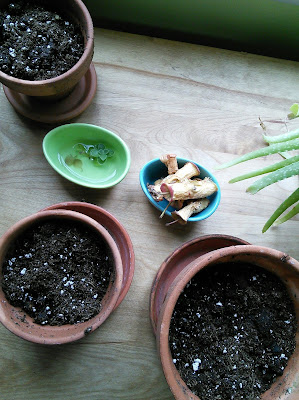The potting soil arrived and, before I repot the bigger house-plants which are in urgent need, I played a bit.
The Vicks plant in the green dish, I nearly killed twice leaving it past frost last year, then putting it out too soon this year, saving only a remnant, which obligingly started putting roots into water. I forgot one day to check and it was dry. Oh. Nothing daunted, it's started new roots, so I've rehoused her in a pot, next to her friends. And I started an apple pit thing in another pot. A couple of dried cores buried in the pot and a few pits scattered on top. We'll see. After dinner gardening. The third pot above has no occupants yet.
Then through the window I noticed a cheerful little blossom struggling up outside through the iris and daylily and pachysandra and vetch and scarlet pimpernel and Montauk daisies and thyme and sedum and Thai basil and lavender and whatever they call that pretty ground creeper that gets yellow flowers.
It's the scrawny little azalea I rescued from across the street when my friends moved out, and before their tenants moved in. Along with a clump of yellow daisy-like Fall flowers, which I don't like, bitter yellow color, bad taste in my mouth, but the goldfinches love it, so it stays.
Finally, the little azalea is getting going, despite its crowded situation. I've been tossing spent tea-leaves, organic, says she virtuously, around it, in hopes, for a couple of years. Adding acid, they love acid. My rescued rose on the patio, likewise. If I had a holly, I'd include it. They all like additional acid. I'll leave the azalea alone, since she seems to know what she's doing.
I only took a bit of the plant material from across the street, politely leaving plenty for the incoming tenants, though I'd been invited to help myself. It was a waste of honesty, though, since the first thing the new people did was tear out every living thing, leaving a wasteland in front of the house. Scorched earth policy. I guess they prefer mud.
So it's good I transplanted what I did. I'm at the other end of the spectrum, my tiny area crowded like a permanent rush hour. The amphibians and worms and birds and bees of all kinds, and praying mantis, love it, so I'm not arguing. And there's no room for weeds.
A certain amount depends on your definition of weeds, of course.
I'm pretty sure if I suddenly found purple loosestrife or phragmites grass out there, I'd yank them out sharpish, they being the Al Capones of the plant world. But other than that, not so much. Since we have cold winters, plants like bindweed die off annually, so they're not the infernal pests they are in other states.
This is big talk from someone who just potted two four inch pots, no?



Rescued plants are my favorite kind of plants.
ReplyDeleteAll my house-plants are either rescues or grown from slips. I can't understand people buying full grown plants. They miss the best bits.
DeleteI did some planting experiments this week too. One of my tomato seedlings had an ungainly extra branch, so I clipped it off and put it in water to see if it would sprout roots along the stem (as they do when planted in soil). Yes! Then an accident with a pepper seedling lopped it off just above its cotyledons. Oops! Would it be able to produce true leaves, without any real leaves to capture energy from the sun? Yes! Gosh, plants sure have a will to grow. Then today I dumped a flat of fifteen basil seedlings upside down on the ground when juggling a garden gate. Drat! All but one survived relatively intact; the unfortunate one had to be nipped off just above its cotyledons too. We'll see if it has the same determination.
ReplyDeleteSo - I'm right there with you with experiments and rescues.
Cheers,
Chris from Boise
Yes, I think it's good to remember that plants have an enormous will to survive.
DeleteI also do a "plant rescue" upon occasion, though usually I just take two or three cuttings and root them.
ReplyDeleteIts like magic when cuttings take off. When you see the first signs it's so satisfying.
DeleteOur previous garden at the house came pretty much entirely from donations from friends and families (and, I suspect, a few other people who wanted to join in the fun). There was a huge amount of horror here a few years ago when the purple loosestrife they planted to 'fix' some other issue started taking off and overpowering native plants. THEN the powers that be thought it would be a wise move to import a type of ladybug that was supposed to kill loosestrife - only those ladybugs aren't the cute little ones we like. The new ones bite! Oddly enough, the loosestrife didn't end up being as much of an issue as they thought and now we're stuck with those miserable bugs.
ReplyDeleteThose Asian ladybugs, yes. I think people are getting smarter about introducing species to a new region. Around here, precious preserved wetlands, very high water table, is perfect for loosestrife and phragmites grass to take over and spifflicate everything else,so it's a real enemy of native plants which feed all the wildlife.
Delete